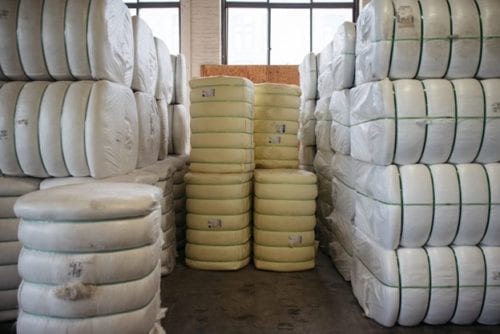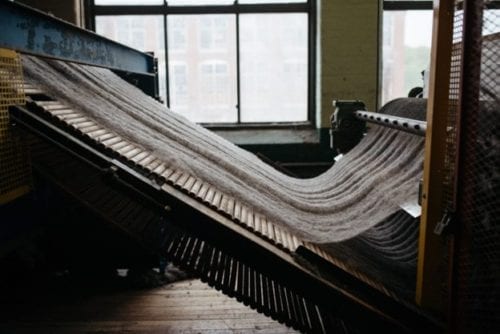Needle Punch Felt, What Is It and How Is It Made?
What is needle punch felt? When most people think of textiles, they think of products like shirts, jeans, and blankets. But the world of fabric goes far beyond clothing and blankets. Textiles are used to make everything from the seatbelts in your car to acoustic panels or desk dividers in your office to the blue medical PPE masks that everyone has become used to in 2020.
Most of the fabrics you encounter each day are woven or knit (think of those warm blankets your grandma knitted for you as a kid). Even most of your shirts are made this way except they use much thinner fibers. If you look closely at the clothes you are wearing, then you will likely see a very small grid pattern.

But a large portion of the fabric that we encounter every day is made using “nonwovens”. As the name suggests, nonwoven felt is made by joining fibers through methods other than weaving such as by using needle entanglement, heat, moisture, or pressure to hold the fibers together.
One of the most well-known types of nonwoven is children’s craft felt. Remember that colorful fabric you used to make your art projects? That is made using a nonwoven construction technique called “cross-lapped needle punch” or more simply “needle punch.”
Needle punching is one of the methods used for making a nonwoven felt. This involves taking loose fibers and “needling” them together using a needle loom full of barbed needles to force the fiber to push through and entangle itself. It is also one of the types of nonwoven that Bouckaert Industrial Textiles specializes in producing.
What Applications is Needle Punch Felt Used For?
Beyond craft felt, needle punch felt has many uses, often in highly technical applications. Some of the most common uses are:
- Soundproofing
- Acoustic panels and baffles
- Filtration
- Equestrian saddle pads
- Office and desk dividers
- Padding for vehicle sun visors
- Molded automobile headliners and trunk liners
- High-performance thermal insulation
- Vibration isolators
- Mattress pads
- Synthetic soil growing media
- Under-carpet
- Gasketing
How Is Needle Punch Felt Made?
Design:
The process for making needle punched felt begins with determining the final use for the felt and what properties it needs. Depending on whether the goal is to create a thermal “heat shield” or under carpet padding or filtering COVID19 particles out of a house filtration system, will create very different needs for how an engineer will create a product.
For any type of nonwoven, including needle punch felt, this process starts with fiber selection. Different fibers have different characteristics that provide different traits that can help with different requirements and can potentially be combined in different percentages to create even more capabilities in the finished felt.
Once the desired fibers have been chosen, other specifications such as weight per sq yard, thickness, surface texture, and many other factors must be determined to achieve the optimal product for the end-user.
Construction:
Once all of the design engineering has been determined, the construction of the felt starts with large bales of loose fiber. These fibers can be synthetic like polyester, nylon, acrylic, rayon, or fiberglass, or they can be organic like wool, cotton, or alpaca.

These bales of fiber must then go into machines called bale breakers. These machines break the compact bale of fibers apart so that they are easier to process.

Many felts involve mixing different types of fiber together in order to get the desired outcome. This is done by carefully weighing the fiber that goes from the bale breakers into the next step of the process, blending and carding to achieve the correct % of the blend.

The breaking up and mixing of fiber is done at carding. Carding works by feeding loose beds of fiber into large wired rollers. This wire works to separate each strand of fiber, mix and blend the components together and orient the fiber in a single direction.
The fiber exits the carding machine in the form of a web. This webbing is similar to the fake spider webs you see around Halloween time and resembles the consistency of cotton candy. It is the first time the fiber looks like a fabric but, just like cotton candy, this material has very little strength to it.

This webbing is laid onto a conveyor belt which carries the web to a cross-lapper. The lapper folds each thin layer of webbing over itself which provides weight and thickness to the finished felt. The number of layers depends on the target thickness and weight of the finished product.

After the lapper, the layers of webbing will enter the needle loom. This is where needle punch felt gets its name.
A needle loom is a precise machine that uses barbed needles mounted on a needle board to pierce the layered web of fiber. The needle boards punch the fibers at a rate of 600-2,000 punches per minute. This repeated punching of needles entangles the fibers together which creates a strong bond. Needle looms can be “in-line” or “off-line.”
This is the end of the felt-making process for some felts. But others go on to receive different finishing treatments such as additional needling or adding more layers of felt to build density, heat treating, calendaring, singeing, and laminating. Some felts also get combined into composite layers with other felt, foam, rubber, or other materials. Here is a quick video of an “off-line” needle loom that is further entangling (or densifying) a piece of felt.
Whether creating an automotive heat shield, an acoustic panel, an industrial felt for gasketing, or any other needle punch nonwoven. Bouckaert Industrial Textiles is here to help you engineer the best product to meet your needs. If you think that a nonwoven felt might be the right choice for your application or have any other questions, then contact us today!

